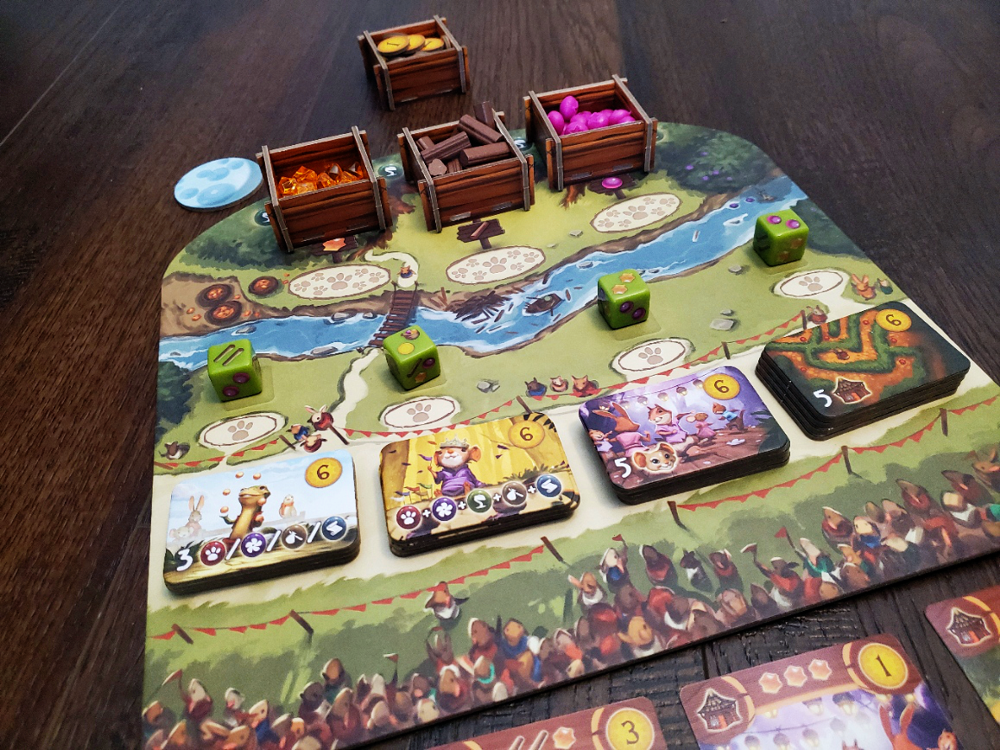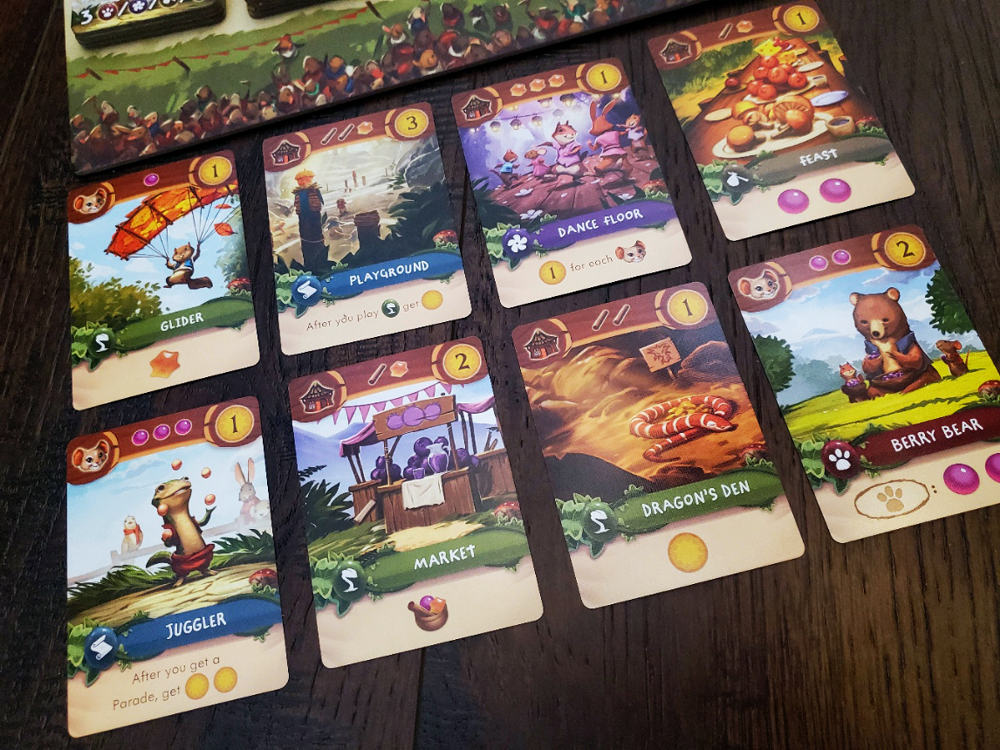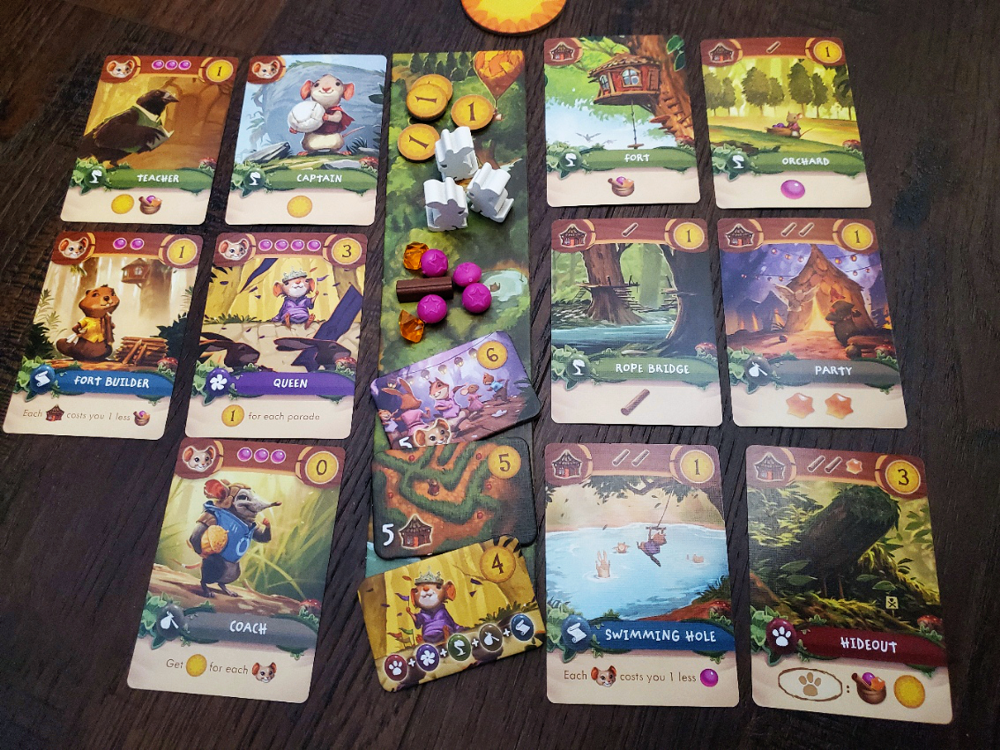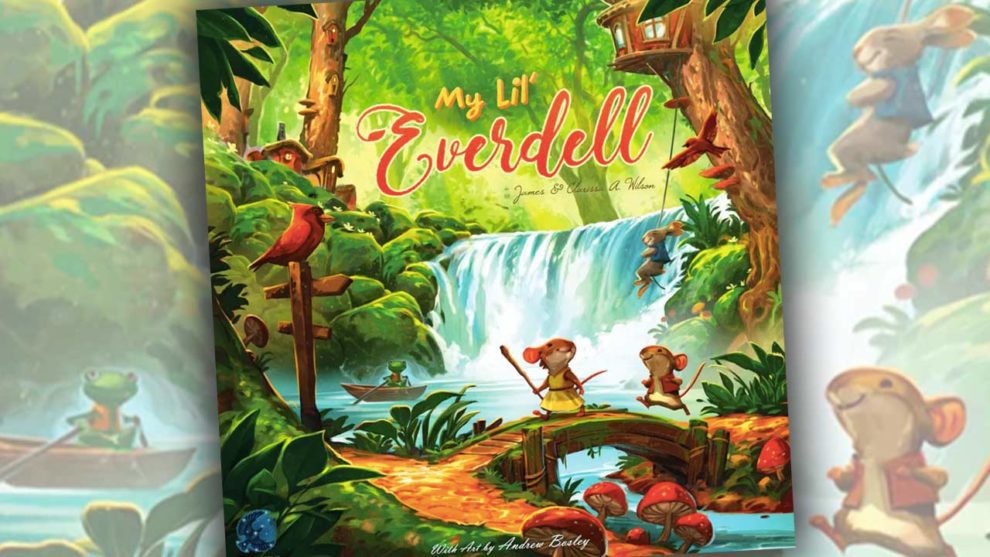Disclosure: Meeple Mountain received a free copy of this product in exchange for an honest, unbiased review. This review is not intended to be an endorsement.
Many moons passed in anticipation of Everdell’s big box Kickstarter fulfillment, which closed the canon, so to speak, on the popular 2018 release. Five boxed expansions having come to rest around and atop the original board, the Meadow now lacks the geography to stretch further toward the horizon in any one physical direction. As one who has given many hours to the vehement adoration of all things Everdell, I am sad that our three dimensional world can’t handle any more.
You know what they say, though: if you can’t dig a hole in the table to stretch down, you’ll just have to stretch chronologically. Ok, maybe no one says that. But that’s the idea with My Lil’ Everdell, the latest release that arrived as a pleasant surprise at PAXU. James and Clarissa Wilson have taken their beloved world back in time to provide a more childlike endeavor designed to introduce the landscape, the mechanics, and the squishy berries to the next generation of gamers. The characteristically comforting art of Andrew Bosley serves again as the welcome point to my favorite land in tabletop gaming.
As difficult as it may be given my experience and obviously biased opinion, I’ll be treating My Lil’ Everdell according to its own merits to the best of my ability.
The Lay of the Land
My Lil’ Everdell is a tableau-building worker placement game, meaning players spend their dozen turns sending Friends to the Meadow and gathering resources to purchase cards—Critters and Places—to lay out on either side of a rectangular home board. These cards then become the means for setting up Parades, which are achievements based on collecting particular card combinations.

On each turn, players place a Friend to gather resources. Three basic locations contain crates full of tokens representing resin, twigs, and squishy berries. The loot for up to four additional spaces is determined by rolling a number of dice depending on the player count. The dice-driven spaces are more lucrative, but only one Friend can visit each of these treasure troves in each of the game’s four rounds. As the game progresses, players may also gain cards that open private locations for resource collection.
After placing a Friend, players then have the option to purchase one card from the eight face-up choices in the Meadow. In addition to being Critters or Places, the cards are divided into five different-colored types, each providing unique blessings and counting toward the Parades. Some cards give immediate resources. Others also produce in future rounds. Some bend the rules ever-so-slightly for bonuses, while others grant end-game scoring.

Play continues clockwise until each player has placed their three Friends, playing up to three cards, and collecting the various spoils. In between rounds, the Moon marker is advanced to the next round, the Sun marker is bestowed to the new first player, the dice are re-rolled, and every green card in play produces Goodies for its owner. Rinse and repeat until the game ends.
If during a turn a player happens to achieve the condition of a Parade, they immediately gain the topmost scoring token. The tokens range from six down to three points, rewarding those who reach the milestones first, which include: gaining five Critters or five Places, gaining one of each card type, or gaining three of a kind—excluding the green production cards. Parades keep player eyes open all around the table as the game is a constant estimation and attempt to reach the four goals before anyone else to maximize scoring.
In order to level the playing field for the younger gamers, there are two suggested variants. First, give players one of each resource to jump start their purchasing power. The second, and more potent, is a pair of cards to expand the littl’un’s tableau from the beginning. The Captain and Fort put young players one card closer to three of the Parades before the game begins. As green cards, they also grant a point token and a resource at the start of each round.

Once the game ends, scoring arises primarily from Parades and the values—both the base value and, potentially, the end-game scoring—on each of the cards. The remainder comes from accumulated point tokens and one point for each pair of leftover resources.
Going it alone
The solo effort in My Lil’ Everdell is exceedingly simple. So simple, in fact, that the rules for the two solo opponents each fit on one side of a card in largely graphic form. Neither opponent takes resources. They block spaces and take cards before joining in the end-game scoring. Rather than accomplishing Parades immediately, they are granted at the end of the round to give players a chance to respond to the random collection.
Prince Pumpernickel blocks the left-most dice location with a Friend or takes a seat at the berry crate before taking a card from the Meadow for free. Cards are chosen by rolling an eight-sided die and selecting according to the chart on the card. Easy peasy. Prince Pumpernickel can even be employed as an extra AI player in a multiplayer game if the folks at the table are interested in sprinkling a bit of random spice on the experience.

Princess Periwinkle is even simpler. She claims a card via the die and then places one of her Friends in place of the card, effectively shrinking the Meadow with each turn in the round.
Both solo experiences border on being too easy, but there are plenty of available challenges to stiffen the competition. Parades could be obtained immediately. The Prince and Princess could go first every round to play spoiler. They also could start with a Fort and Captain. Though this idea isn’t printed in the rules, they also could collect point tokens throughout the game.
The beauty of the solo experience is that it takes a solid 15-20 minutes, so there is ample room for experimentation to achieve varied levels of difficulty.
An Apostrophe
Players of Everdell will have no trouble understanding and enjoying the world of My Lil’ Everdell from the outset. There are, however, several changes that give this introductory experience a unique flavor without trampling the original design.
The Parades are a lovely shift away from the Events of the original. The fact that there are multiple finishers in each category opens the door to a different sort of competition and an entirely different tension around the table. I really enjoy the relatively low consequence of the decreasing reward tiers. It is a friendly twist, but one in which the difference ultimately matters. This lil’ experience is often a fierce competition for a relatively narrow spread of points.
The absence of the pebble is lamentable, but in the name of simplicity, I get it.
The ability to gather resources and play a card in the same turn is a massive shift, but the tension shifts instantly as well to accommodate. Ultimately, each player maxes out at a dozen cards (unless they start with the Captain and Fort, which drive the total to fourteen), so the limit feels familiar. But the acquisitions occur at a more sprightly pace and the temptation to purchase a less-than-optimal card for the sake of hitting the dozen is always present. Most turns include the pressure to do a lot with a little while saving to eventually score the big card. Landing the EverTree feels the same even though the experience is obviously different.
The dice are a pleasant exchange over the cards. The fact that they change from round to round keeps the game in the tactical realm rather than the strategic. But they hold all the allure of the Forest locations in the original without the ability to develop any long-term plans to gain their wares. My Lil’ Everdell is an exercise in fit and timely reactions.
And the BIG bonus for all you Everdell lovers—the Kindergarten & Kids promo expansion for the original was a lovely surprise! Reminiscent of the Scurrble Champions, these cards depend on collecting multiples to make them truly worthwhile. Depending on the size of your deck, you’ll find they appear more or less often than you might like, but I was thrilled to find them inside the box.
The Apostrophe
I’m not sure why the apostrophe in Lil’ is misplaced. I will be forever irked unless there is a charming story behind the change. As yet I’ve not heard one, so I must wake up morning by morning to the unfortunate error. Typing this review has been difficult. But like typing Zombie Kidz or Cytosis, sometimes you have to overlook the unusual and/or out-of-place title when you love a game.
My Lil’ Dulce Domum
And I do love My Lil’ Everdell.
I think this is a beautifully instructive game for folks who are new to several gaming concepts. As a worker placement game, the economy is exceptionally tight while keeping the mood light—what a gift! There are often options across a spectrum of possibilities at all times, allowing for a relatively comfortable learning curve. As a tableau-builder, the presence of the simple Home board that divides Critters and Places breaks the concept down to help with organization and assessment. With regards to set collection, the Parades teach and reward attentiveness. While the game is clearly aimed at children with the My Lil’ business, whole families can get into the hobby with a title like this, and I could see it playing well for quite some time.
On the flipside, I don’t think dedicated gamers will play My Lil’ Everdell forever. There are 54 cards in the deck. In a four-player game, every card will come into play, meaning within a few games most of the lucrative combinations will see the table. Games like this struggle to hold folks whose eyes are set toward variety. One of the strengths of the original Everdell is the depth of the deck, but that depth is sustained by the additional mechanisms that allow flexibility in the variety. This introductory deck will eventually reveal most, if not all, of its secrets.
That being said, the two and three-player affairs are perhaps a bit more interesting because of the withheld cards. I see this particularly in the purple/prosperity cards. If end-game bonuses are guaranteed to show themselves, players can simply wait and—with a touch of luck—pounce in the four-player game. Spending a game collecting tan/traveler cards will eventually pay off because the Zip Line will arrive on the scene and you’re likely to be the only one who really wants it. With only twelve cards to play, spite purchases are less appealing when another more useful option is present.
The box is fairly accurate with regard to time and age. Most of our games hover around a half-hour, especially now that the kiddos know the flow inside and out. Our five-year-old has a full grasp of the mechanics. With each passing game, she’s better understanding some of the interplay of the cards. We give her the Captain and Fort every time. Below ten years old, we give the kids the resource bonus and we’ve found it to be fairly competitive.
On the production side, the materials are suitable all around. The rule book is exceptionally well laid out—crystal clear from start to finish with examples throughout. The cards are delightful. Several of the familiar characters and places make appearances, but with more childlike depictions. The cardboard crates are tight in assembly almost to a fault, but they are sturdy once constructed. In the solo affair I don’t even bother with them, but they give the game a nice flair with the kids. The resources, which are the same as the original, are still among my favorites in any game. The mice, butterflies, foxes, and lizards are all familiar in their quality.

I can’t help but think of a game like 7 Wonders: Architects when I look for a comparison point. It’s always fair to ask whether another iteration of a beloved game is really necessary. But when the new production opens the gaming door wide to a younger demographic, I welcome the addition. Just as Architects opens the door to 7 Wonders and 7 Wonders: Duel along with a bevy of titles with similar ideas, I believe My Lil’ Everdell will help folks jump into the more complex and rewarding original. More than that, I can see families taking up the hobby together because of this catchy little number.
It’s a little late for Christmas shopping, but next time you’re eyeing up a gift for a family with a few young kiddos, I’d seriously consider My Lil’ Everdell. If you’re a fan of Everdell and you have young’uns, I’d say the same. Just beware: if you give a mouse a board game, he might just become a hobbyist.
One year later
As I expressed in this review, My Lil’ Everdell is the sort of game that can provide great hours around the table for all ages. But it is also the sort of game that will eventually reveal its storehouses, at which point decisions must be made. In the end, we traded our copy once we played it through. I stand by calling it a fantastic family game, a great introduction to hobby gaming, and a worthy investment. but we reached a point where we knew it was time to move on to other titles. In some ways, the release and review of Farshore might have hastened the release of this introductory box. Seeing various iterations of the Everdell system has only pushed me with greater fervor back toward the title that got it all started. I really enjoy seeing what the design team can accomplish, but none has (yet) tickled our family in quite the same way as the original meadow. Inevitably we go back to basics (so to speak) and find that the elements we love most are most forcefully present in the game we’ve loved all along. Only our youngest (now six) isn’t in the fold with our outings in the original. She will get there, and we’ve got a lot of great titles to bide the time until then.












Add Comment